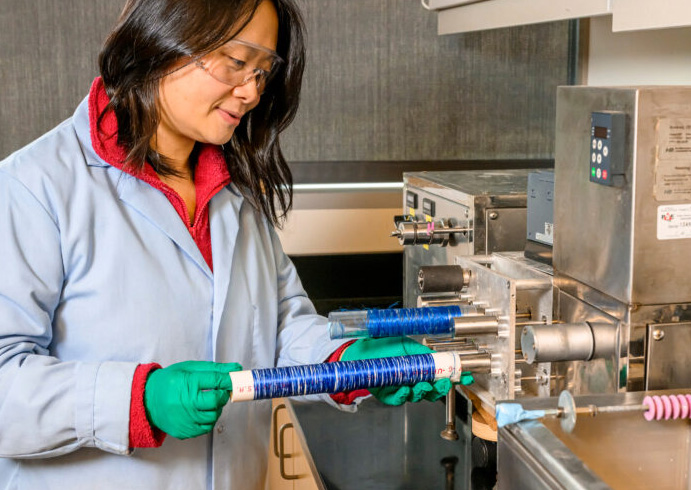
Smart fabrics are an accelerating textile trend, offering the promise of clothing that can perform the same tasks as watches and other monitoring devices. “We already have smart wearables, like smart watches that track body movements and human vital signs,” states Hang Liu, Ph.D., Associate Professor and Lead Textile Researcher at Washington State University (WSU). “However, we hope that future everyday clothing will do these functions as well.”
Under Liu’s direction, WSU has developed a new cotton-based single-strand fiber, which combines the flexibility of cotton with the electrical-conductivity of a polymer. The new fiber shows positive potential for wearable e-textiles, with applications in healthcare, first responder/military uniforms, as well as in athleticwear.
Conductive, Cotton-Based Textile Fiber Technology
The technology integrates recycled cotton and a conductive polymer. Typically, polymers are substances with long molecule chains that have repeating patterns. The WSU research team selected polyaniline (also known as PANI), a synthetic polymer that has been previously used in applications like printed circuit board manufacturing.
However, the use of polyaniline presented a challenge. Although inherently conductive, polyaniline is brittle and is typically unsuitable as a textile fiber. To address this, the team developed a process which involves combining two separate solutions. Cotton cellulose from recycled t-shirts was dissolved in one solution and the conductive polymer was used in a separate solution.
A wet-spun extrusion process was utilized to blend the two solutions to make a single fiber. A biodegradable, nontoxic solvent, Cyrene, was included in the processing. The Cyrene provided a more environmentally-friendly environment than other commonly used solvents, which are toxic. The researchers carefully blended the two solutions to avoid aggressive agitation, so the cotton fiber and the conductive polymer would only intermittently attach to each other.
Liu explains, “Since an over-connection between the two fibers can cause a general reduction in overall conductivity, an accurate, delicate balance between the interfaced cotton cellulose and the polyaniline was necessary to provide the required stability. However, we didn’t want them to mix too much, otherwise the conductivity would be reduced.”
The innovative fibers were tested as part of a system powered by an LED light. Liu says, “Using the light demonstrated that the conductivity level in our cotton-based fiber is enough to power an LED light.” The test results showed good interfacial bonding within the two adjacent fiber segments, the molecules of the materials stayed together through stretching and bending.
Future fiber applications could include sensor-patches with flexible circuits as part of uniforms for firefighters and soldiers, as well as in apparel for workers to detect chemical/hazardous environments. Other applications could include health monitoring in exercise shirts that provide more functions than current fitness monitors offer.
Going Forward
Previous methods of developing smart wearables involved gluing, weaving or sewing functional components, such as conductive threads or sensors, into fabrics. As an alternative, WSU is looking at new approaches involving 3D printing that show promise. WSU also plans to integrate conductive fibers with 3D printed fabrics into one smart sensing system comprising multiple parts (sensing, data processing, power supply, signal transmission, etc.). The new research will concentrate on 3D ink printing methods for smart fabrics that will perform well after repeated washings and abrasion tests. The research represents a technical breakthrough in smart fabric comfort and durability, as well as creating a process that continues its environmentally-friendly focus.
Liu states, “At this moment, we have not integrated our conductive fibers with the 3D printed fabrics, but we plan to do this. Once integrated into a smart sensing system (e.g., a real sensing garment), the conductive fibers and 3D printed fabrics will serve as different functional components.”
Liu is hoping that WSU can start developing a 3D printed fabric system by next year, but she needs additional collaborators to work with her on the project. She continued, “Since this is out of my own research realm, I need to collaborate with others for electrical components, signal transmission, software design, etc. I am in the process of talking to others for potential collaboration now, and the whole smart sensing system testing will be included in a garment worn within real application scenarios.”


.svg)